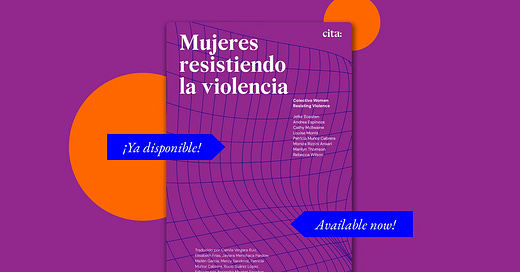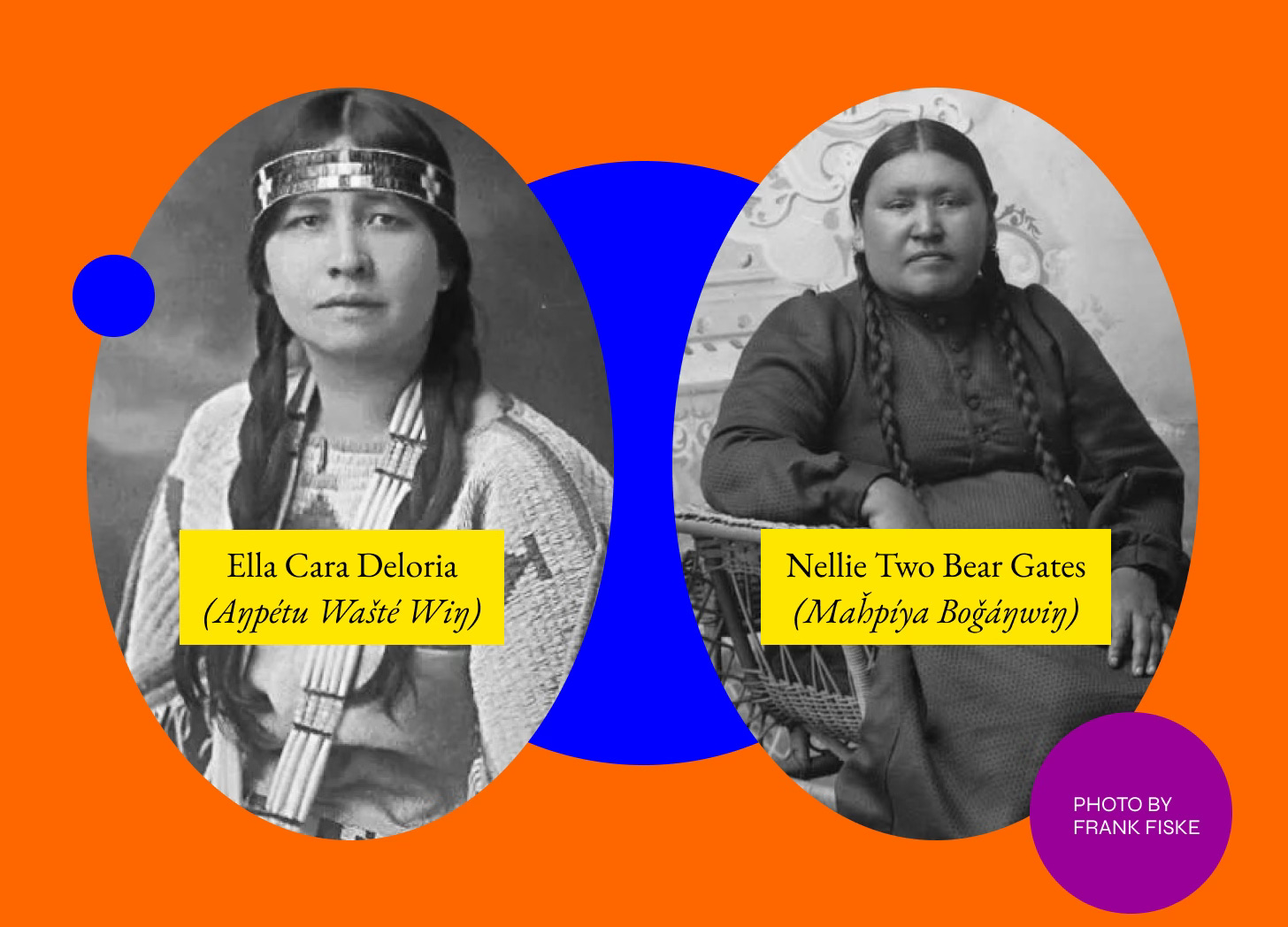“nos sembraron miedo, nos crecieron alas…”/“they sowed fear in us, we grew wings...”
On our new Spanish-language edition of Women Resisting Violence; Ella Cara Deloria and Nellie Two Bear Gates; & more!
On November 25 (International Day for the Elimination of Violence Against Women), in partnership with UK-based publisher Latin American Bureau (LAB), Cita launched our latest contemporary title: Mujeres resistiendo la violencia. This new Spanish translation of Women Resisting Violence (2022, Practical Action Publishing and LAB) makes an important, timely text available to more readers—including people whose work and experiences are examined in its pages.
Mujeres resistiendo la violencia brings together case studies, interviews, historical context, and rigorous analysis to tackle one of the most pervasive human rights issues in the world. The book outlines how the work of feminist activists in Latin America combats violence in its many overlapping forms, and how their strategies can transform more communities and our collective futures. It synthesizes the voices, stories, and topics explored in the broader Women Resisting Violence project, which also includes a multilingual podcast, blog, and events (see below).
The book was authored by members of the Women Resisting Violence Collective (WRV), a group of researchers who prioritize a feminist, intersectional, and collaborative approach. Rebecca Wilson, LAB Managing Editor and WRV Collective member, coordinates the broader project. Just as there were many authors of the English text, many translators worked together on the Spanish edition, which was edited by Alejandra Montes Escobar.
The new edition, like all Cita books, is available to read for free from anywhere in the world—all that is required is an internet connection. The English edition of the book can be purchased from Practical Action Publishing in print or ebook. Readers can also explore:
The three-part podcast, which features interviews from activists and leaders from the book, is available in English, Spanish, and Portuguese on all platforms.
The WRV blog, which is updated regularly in English.
LAB’s site for the book to see how certain podcast episodes and blog posts connect back to specific chapters.
The process of writing the book and making it available to readers in Spanish reflects the larger aims and the values of the Women Resisting Violence project. As Alejandra explains:
Es un libro sobre mujeres, ideado, escrito, traducido, editado y divulgado por mujeres, que creemos en la importancia de hablar pública y abiertamente sobre la violencia de género. Mujeres que defendemos el apoyo mutuo, el compartir, escucharnos y apoyarnos entre mujeres, porque solo así es que vamos a poder combatir estas violencias que nos tocan a todas, de maneras distintas. Cuando creemos en la causa de lo que hacemos, los procesos fluyen con mucha armonía.
It is a book about women: conceived, written, translated, edited and distributed by women who believe in the importance of speaking publicly and openly about gender violence. Women who believe in mutual aid, sharing, listening to and supporting each other—because only in this way will we be able to combat violence that affects us all, in different ways. When we believe in what we do, processes can flow very harmoniously.
We are grateful to Rebecca Wilson and Alejandra Montes Escobar for being such wonderful collaborators, and to everyone at LAB and WRV Collective for trusting Cita Press with this project.
Lee aquí Mujeres resistiendo la violencia. (¡EPUB descargable próximamente!)
Latinoamérica es el continente con mayores índices de violencia contra las mujeres y las niñas, pero, a su vez, con una tremenda potencia para resistencias múltiples. Este libro demuestra una vez más la importancia de los lazos de sororidad entre feministas de la academia e indígenas feministas que proponen creativas formas de resistencia y teorización desde el sur. Como dice la canción: nos sembraron miedo, nos crecieron alas…
Latin America is the continent with the highest rates of violence against women and girls, but, at the same time, with a tremendous power of multiple resistances. This book demonstrates, once again, the significance of the bonds of sisterhood between academic feminists and indigenous feminists proposing creative forms of resistance and theorizing from the South. As the song says: “they sowed fear in us, we grew wings...”
-Rocío Silva Santiesteban, poeta peruana, activista feminista, académica y excongresista
Cita Canon Spotlight
November is Native American Heritage Month in the US. Last month, we published Planted in a Strange Earth: Selected Writings by Zitkála-Šá. (See Zitkála-Šá in the November 2023 canon highlight.) This month, we celebrate two other Yankton Dakota women who were connected to assimilationist boarding schools but then dedicated their time and talents to the preservation of Sioux history and traditions. Both women are also part of families with a legacy of art and activism that extends to today.
As an ethnographer, anthropologist, linguist, and novelist, Ella Cara Deloria (Aŋpétu Wašté Wiŋ, 1889-1971) worked to record and preserve Native languages, traditions, and storytelling. After an early career teaching in places like Haskell Indian School, she began working with anthropologist Frank Boas. She went on to collaborate closely with Boas and his fellow Columbia anthropologists Margaret Mead and Ruth Benedict. She was the author of several books, including Dakota Texts (1932), Dakota Grammar ( with Boas, 1941), and Speaking of Indians (1944). By transcribing and translating a large volume of stories, speeches, myths, and histories, she created a vast and diverse written record of material from Sioux oral traditions.
In the 1940s, Deloria began working on a novel focused on nineteenth-century Sioux life from the perspectives of women. Though completed by 1948, Waterlily was not published until 1988 (by University of Nebraska Press’ Bison Books). In the afterword, Raymond J. DeMallie writes: “Ironically, the very qualities that made Waterlily unpublishable at the time it was written are those that make it of such interest today. It represents a blurring of categories: in conception it is fundamentally a work of ethnographic description, but in its method it is narrative fiction.” In 2022, her long-neglected cultural study The Dakota Way of Life was finally published (Bison Books, edited by DeMallie and Thierry Veyrié). The Waterlily Storytelling Institute, hosted by the Brave Heart Society on the Yankton Indian Reservation, is named in Deloria’s honor.
Deloria’s sister, Mary Sully, was an artist who created the cover for the first edition of Speaking of Indians. (Mary Sully: Native Modern is currently on view at The Met!) The sisters’ nephew, historian and activist Vine Deloria, Jr., wrote the introduction for the 1998 Bison Books edition of that text.
[Introduction to the 2009 edition of Waterlily by Susan Gardner, via DigitalCommons@University of Nebraska - Lincoln.]
Artist Nellie Two Bear Gates (Maȟpíya Boǧáŋwiŋ, ~1854–1935) memorialized history through intricately beaded works of art. The daughter of Chief Two Bear, a highly respected Yankton leader, Gates attended a Catholic boarding school from ages seven to eighteen. After over a decade of separation from her family, language, and culture, Gates left the school to live with her family at the Standing Rock Reservation. An article in the Cambridge Chronicle in 1899 framed her return to Dakota life as “"Nellie Two Bears: The Relapse of an Indian Princess into Barbarity".
Gates’ legacy of refusing to let her identity and culture be erased extends into our present day through her art, and also through her family line. In 1903, she created a beaded valise showcasing important moments in their family and tribal history as a gift for her daughter, Josephine, upon her graduation from Carlisle Indian Industrial School. Josephine Gates Kelly later followed her grandfather’s example, becoming the first woman elected to chair a tribal council in 1946. Gates’ granddaughter, Susan Kelly Power, was an activist who co-founded the American Indian Center in Chicago in 1953. Her great-granddaughter, Mona Susan Power, is an award-winning author. Power's 2023 novel A Council of Dolls draws from her family story to follow three generations of Yanktonai Dakota women, weaving in elements like the Chronicle article. In the author’s note, Power writes:
Nellie Gates was a renowned beadwork artist, who work is still honored for its beauty and power. My mother carries fond memories of her khúŋši’s humility, kindness, and dignity, which demolish the racist caricature portrayed in the newspaper. Such outrageously prejudiced depictions of my ancestors and our people are one reason I became a writer. From childhood I felt an urgent need to speak my truth, which was long suppressed.
[Valise by Nellie Two Bear Gates at Hearts of Our People: Native Women Artists; Susan Kelly Power and Mona Susan Power on Jacqueline Gates Kelly for On Second Thought]
Cita News
Mariana Matos has joined Cita Press as Communication and Design Coordinator! Mariana is an interdisciplinary designer based in Detroit, MI. Learn more about her work, which explores the intersection of digital and physical design, here.
A couple of weeks ago we got together with ~60 other exhibitors and 1,800+ guests for the inaugural Off Register Art Book & Print Fair in Santa Barbara, California. Thank you to everyone who came out to chat about books + art, buy Cita merch, and discuss “New Life in the Public Domain!” Learn more about how the event came to be via the Santa Barbara Independent.
Speaking of merch: this holiday season, treat the book friends in your life to apparel, posters, and books from the Cita shop—all shopping helps support our free library!
We want your book recommendations! Each December, the Cita team compiles a list of recent-ish books by women we read and loved during the year. Send us the book title/author and one sentence about why you recommend it to Cita readers to info@citapress.org. We’ll include the recommendations in next month’s Bulletin. (Last year’s list is here.)







